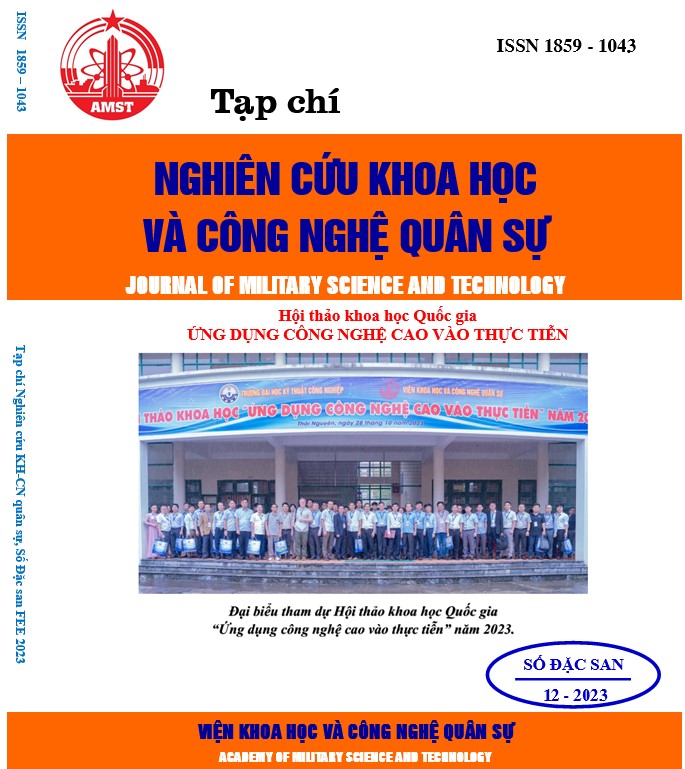Bộ điều khiển FLC-Sugeno tối ưu dựa trên PSO cho hệ thống giảm chấn tích cực
390 lượt xemDOI:
https://doi.org/10.54939/1859-1043.j.mst.FEE.2023.55-63Từ khóa:
FLC-sugeno; Tối ưu bầy đàn; Hệ thống giảm chấn tích cực; Mô hình giảm chấn 1/4.Tóm tắt
Trong bài báo này, chúng tôi trình bày một phương pháp thiết kế bộ điều khiển mờ theo mô hình Sugeno (FLC-sugeno) tối ưu cho hệ thống giảm chấn tích cực. Các tham số của bộ điều khiển được xem xét một cách tổng thể và được tìm kiếm tối ưu bằng thuật toán PSO (Particle Swarm Optimization algorithm). Bộ điều khiển này có 16 tham số được tối ưu bao gồm: 03 tham số hiệu chỉnh miền xác định của các biến trạng thái đầu vào và biến điều khiển ở đầu ra của bộ điều khiển, 04 số hiệu chỉnh tập mờ của các biến ngôn ngữ và 09 tham số là trọng số luật mờ của hệ luật điều khiển. Để đánh giá và so sánh tính hiệu quả của bộ điều khiển FLC-Sugeno tối ưu, một bộ điều khiển PID tối ưu bằng PSO cũng được thực hiện. Kết quả mô phỏng hệ thống giảm chấn tích cực với các bộ điều khiển khi cùng chịu tác động một loại và kích thích mặt đường tiêu chuẩn cho thấy FLC-Sugeno tối ưu cho thấy biên độ chuyển vị của thân xe là giảm đáng kể. Kết quả này cho thấy, một hướng mở rộng khi áp dụng hướng thiết kế cho các hệ thống giảm chấn tích cực phức tạp hơn.
Tài liệu tham khảo
[1]. Pekgökgöz, Recep Kadir, et al. “Active suspension of cars using fuzzy logic controller optimized by genetic algorithm.” International journal of engineering and applied sciences 2.4: 27-37, (2010).
[2]. Allam, Essam, et al. “Vibration control of active vehicle suspension system using fuzzy logic algorithm.” Fuzzy Information and Engineering 2.4: 361-387, (2010). DOI: https://doi.org/10.1007/s12543-010-0056-3
[3]. Changizi, Nemat, and Modjtaba Rouhani. “Comparing PID and fuzzy logic control a quarter car suspension system.” The journal of mathematics and computer science 2.3: 559-564, (2011). DOI: https://doi.org/10.22436/jmcs.02.03.18
[4]. Chen, Zhengke. “Research on fuzzy control of the vehicle’s semi-active suspension.” 2015 International Conference on Management, Education, Information and Control. Atlantis Press, (2015). DOI: https://doi.org/10.2991/meici-15.2015.111
[5]. Palanisamy, Senthilkumar, and Sivakumar Karuppan. “Fuzzy control of active suspension system.” Journal of Vibroengineering 18.5: 3197-3204, (2016). DOI: https://doi.org/10.21595/jve.2016.16699
[6]. Bhangal, Narinder Singh, and Kumar Amit Raj. “Fuzzy control of vehicle active suspension system.” International Journal of Mechanical Engineering and Robotics Research 5.2: 144, (2016). DOI: https://doi.org/10.18178/ijmerr.5.2.144-148
[7]. Basari, A. A., et al. “Fuzzy logic controller for half car active suspension system.” Journal of Telecommunication, Electronic and Computer Engineering (JTEC) 10.2: 125-129, (2018).
[8]. Han, Shi-Yuan, et al. “Adaptive fuzzy PID control strategy for vehicle active suspension based on road evaluation.” Electronics 11.6: 921, (2022). DOI: https://doi.org/10.3390/electronics11060921
[9]. Robert, J. Joshua, et al. “Fuzzy control of active suspension system based on quarter car model.” Materials Today: Proceedings 66: 902-908, (2022). DOI: https://doi.org/10.1016/j.matpr.2022.04.575
[10]. Yazid, N. E. H., et al. “New Fuzzy Logic Control for Quarter Vehicle Suspension System.” Artificial Intelligence and Heuristics for Smart Energy Efficiency in Smart Cities: Case Study: Tipasa, Algeria. Springer International Publishing, (2022). DOI: https://doi.org/10.1007/978-3-030-92038-8_64
[11]. T. A. Arslan et al. “Quarter Car Active Suspension System Control Using Fuzzy Controller”, Engineering Perspective 2 (4): 33-39, (2022). DOI: https://doi.org/10.29228/eng.pers.66798
[12]. Zhang, Zhenxing, and Jiuxiang Dong. “A new optimization control policy for fuzzy vehicle suspension systems under membership functions online learning.” IEEE Transactions on Systems, Man, and Cybernetics: Systems 53.5: 3255-3266, (2022). DOI: https://doi.org/10.1109/TSMC.2022.3224739
[13]. Takagi, Tomohiro, and Michio Sugeno. “Fuzzy identification of systems and its applications to modeling and control.” IEEE transactions on systems, man, and cybernetics 1: 116-132, (1985). DOI: https://doi.org/10.1109/TSMC.1985.6313399
[14]. Kennedy, James, and Russell Eberhart. “Particle swarm optimization.” Proceedings of ICNN'95-international conference on neural networks. Vol. 4. IEEE, (1995).
[15]. Koch, G.P.A.. “Adaptive Control of Mechatronic Vehicle Suspension”. PhD Thesis, Technical University of Munich, Munich, Germany, (2011).
[16]. Bryan Craig Murphy, “Design and contruction of a precision tubular linear motor and controller”, Submitted to the Office of Graduate Studies of Texas A&M University.







